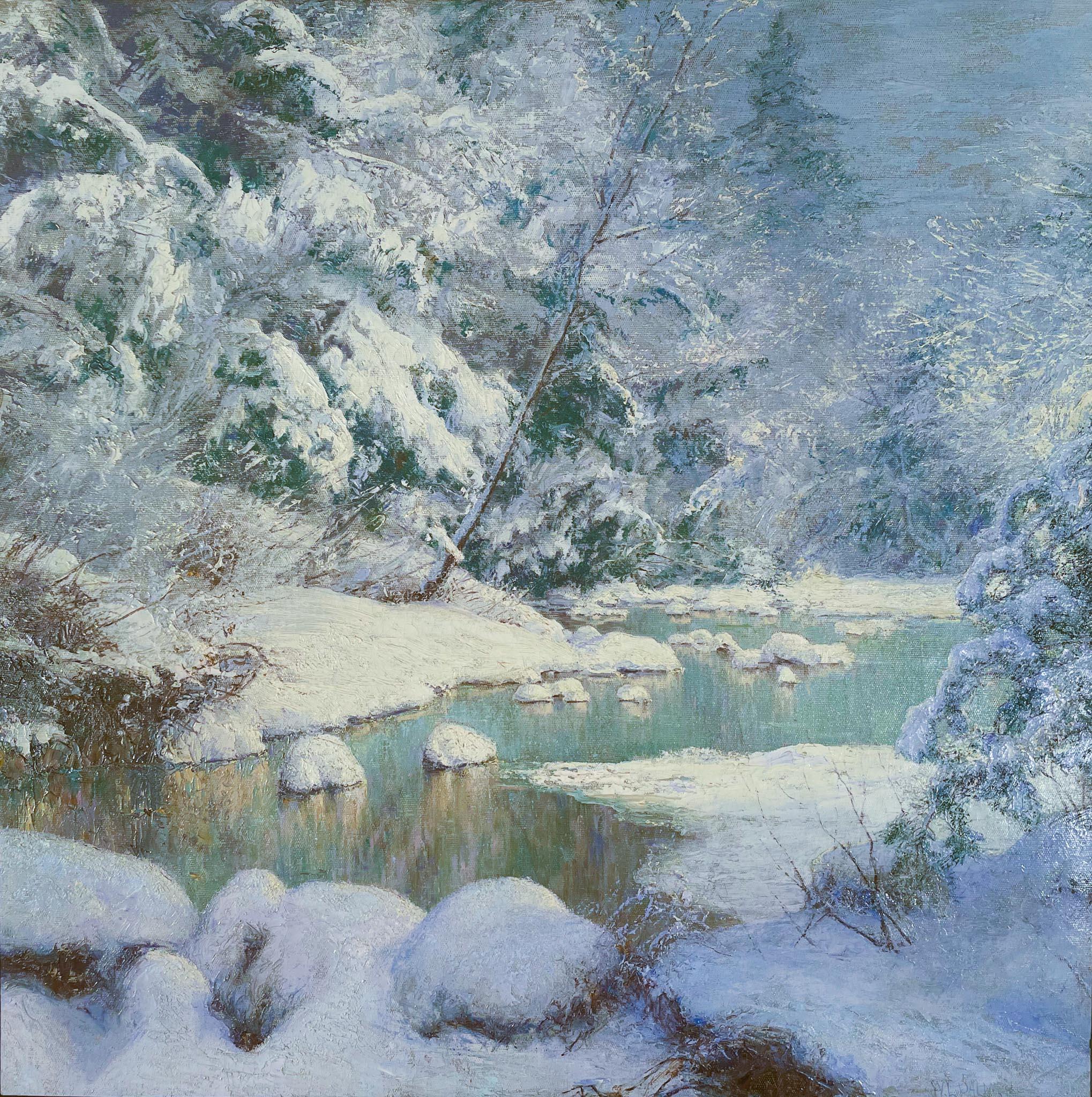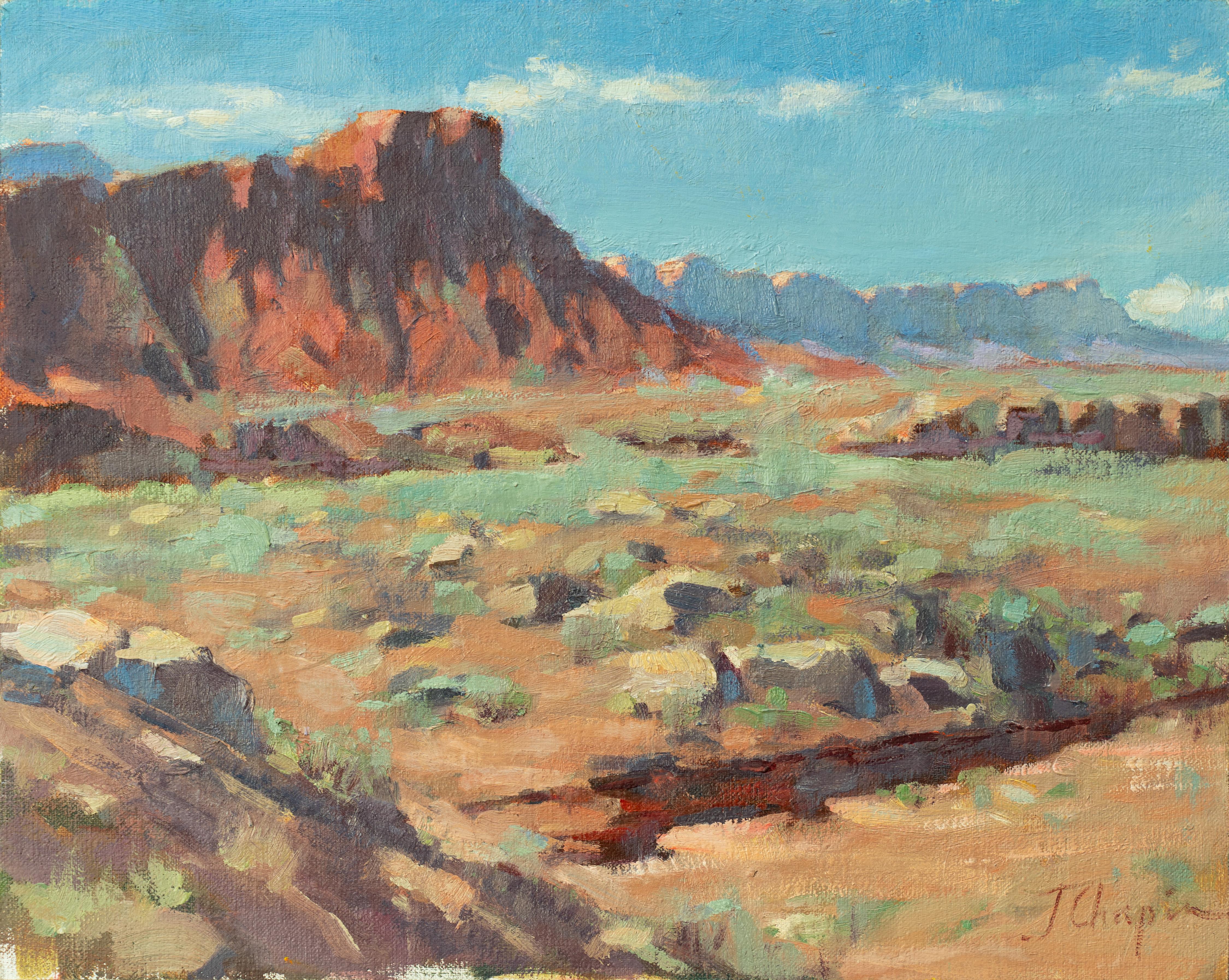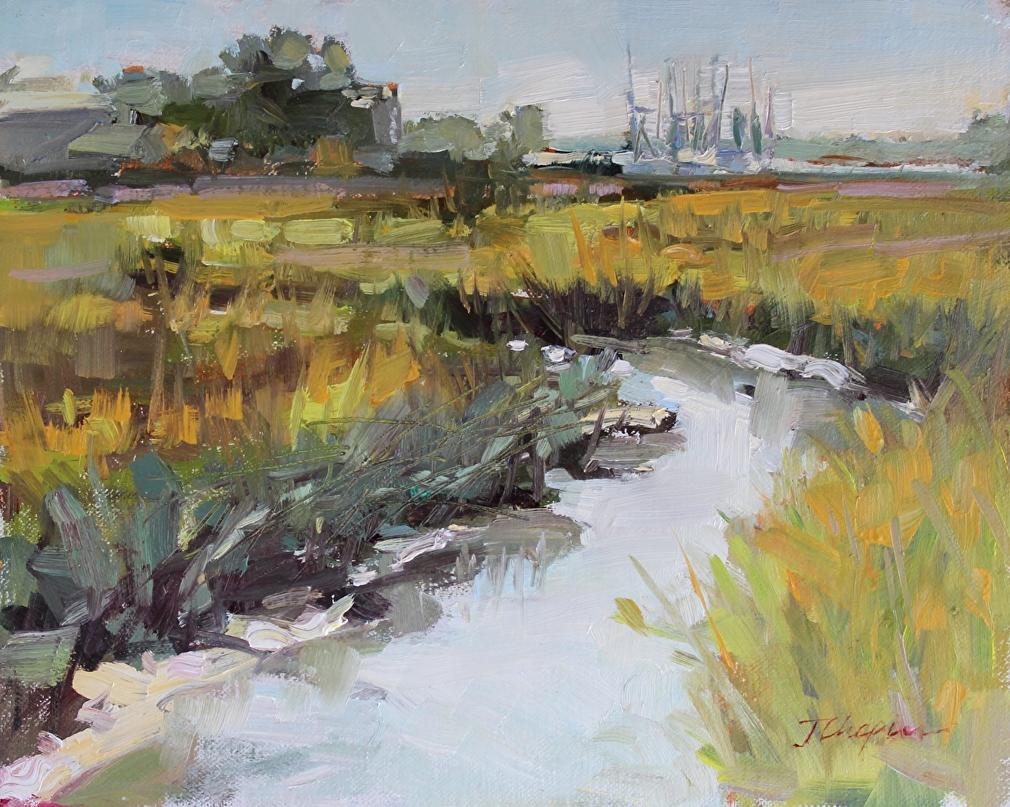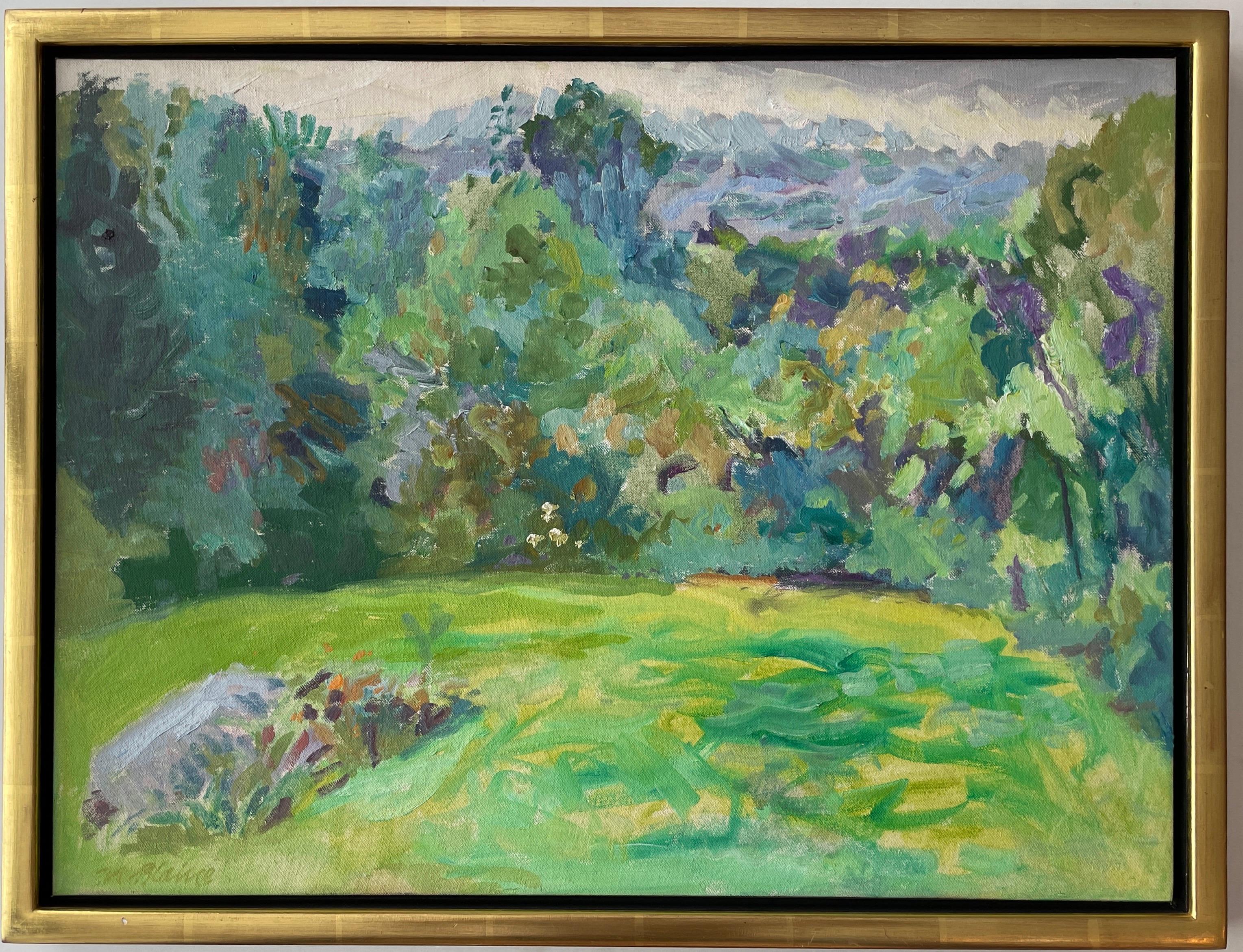Items Similar to Landscape with people fishing
Want more images or videos?
Request additional images or videos from the seller
1 of 10
Morris KatzLandscape with people fishing1978
1978
About the Item
This artwork "Landscape with People Fishing" 1978, is an oil painting on hard board by Polish/American artist Morris Katz, 1932-2010. It is signed and dated at the lower right corner by the artist. The artwork (Hard Board) size is 20 x 24 inches, framed size is 28 x 31.75 inches. Framed in original wooden gold frame, with fabric liner and gold trim. The artwork is in excellent condition, the frame is in very good condition.
About the artist:
On May 9th, 1988, the New York artist set a new world record by painting a 12- by 16-inch canvas of a child in the snow in just half a minute. (It took an additional eight seconds to frame it.) And that wasn’t the only distinction granted to Katz by the Guinness Book of World Records—his name appeared alongside Pablo Picasso’s under the heading for “Most Prolific Painters.” The Spanish master is estimated to have completed some 13,500 paintings in his life; when Katz died in 2010 at age 78, he was credited with 225,000.
Katz’s preposterously productive career began in the small Polish village where he was born in 1932. He started studying under a German painter at age 13, but following World War II he earned a diploma in carpentry instead. In 1949, at the age of 17, he travelled to the United States. It was there that he picked up a paintbrush again, while studying at the Art Students League of New York and showing in the Village. “Soon, I decided I was good enough—compared to others, excellent enough—to make my living as an artist,” he said.
It was during those years that he developed the techniques that would eventually land him in the record books. He tossed out his paintbrushes and replaced them with palette knives and toilet paper, which he used to stipple the paint. “Soon I picked up speed,” Katz said. “If you know which way you’re travelling, then you can run.” He made art in bulk, buying up canvases by the thousands and paint by the gallon. He went through some 10,000 rolls of toilet paper per year; he often wore out palette knives.
Katz branded his method as “instant art.” Charles Salzberg, writing in New York magazine in 1978, urged readers, “Think of him, if you will, as the McDonald’s of the art world”—fast, cheap, and ubiquitous.
He wore a green beret, paint-splattered pants, and a shirt emblazoned with the words “Morris Katz - World’s Most Prolific Artist.” It was a title that came with a price—he worked 18-hour days into his 60s, sometimes from his Greenwich Village studio and other times as a performer at hotels across the Catskills. He would often visit three different hotels in the same day, waking up at 7 a.m. and returning home as late as 1 a.m.
His show was as much about the painting as it was the one-liners: “These are the highlights—you can tell because they’re high up on the painting,” he might say. Audiences gobbled up the jokes and the works, often paying less than $50 for a painting. “I give them a fresh painting like a fresh bagel,” he said.
Photographer David M. Spindel first met Katz on assignment. “They’d call him mashugana—that’s the Yiddish word for a little bit crazy,” he told Artsy. The pair soon became friends, and Spindel ended up attending several of the artist’s hotel shows.
“There were a lot of people from the hotel who were sitting in the room and he set up his easel and his toilet paper and paints and knocked out paintings one after another,” Spindel said. “Just a couple of minutes for each painting, usually. If he was kibitzing with the people in the audience then it took a lot longer. He was always clowning around.”
His act was ready-made for television; he appeared on 60 Minutes, David Letterman, and Oprah, among other programs. And Katz didn’t just make instant art—he taught it as well. In 1987, the New Yorker sent a writer to attend one of his speed-painting classes at the Notre Dame School on West 79th Street. A dozen eager students watched in admiration as he whipped up a mountain landscape, asking for advice on how, exactly, to hold their toilet paper for maximum artistic effect. For those who couldn’t make it to Manhattan for a lesson, he published a book—Paint Good & Fast (1985)—with a title as straightforward as his philosophy on art.
“Life goes faster and faster,” he wrote. “The fine arts must keep pace. This art will one day be viewed as prophetic.”
As Katz saw it, his was the true contemporary art: “fast, democratic and to the point.”
More han 100 museums around the globe own and have exhibited his art, including the Smithsonian which has three of his paintings on display.
- Creator:Morris Katz (1932-2010, Polish)
- Creation Year:1978
- Dimensions:Height: 28 in (71.12 cm)Width: 31.75 in (80.65 cm)Depth: 2 in (5.08 cm)
- Medium:
- Movement & Style:
- Period:
- Condition:
- Gallery Location:San Francisco, CA
- Reference Number:
About the Seller
5.0
Platinum Seller
These expertly vetted sellers are 1stDibs' most experienced sellers and are rated highest by our customers.
Established in 1999
1stDibs seller since 2017
682 sales on 1stDibs
Typical response time: 1 hour
- ShippingRetrieving quote...Ships From: San Francisco, CA
- Return PolicyA return for this item may be initiated within 7 days of delivery.
More From This SellerView All
- Convict Lake, High SierraBy Earl Graham DouglasLocated in San Francisco, CAThis artwork titled "Convict Lake, High Sierra" c.1920 is an oil painting on canvas by noted California artist Earl Graham Douglas, 1879-1954. It i...Category
Early 20th Century American Impressionist Landscape Paintings
MaterialsOil
- Victor at WorkBy Carl Lewis BowmanLocated in San Francisco, CAArtist: Carl Lewis Bowman (American, 1909-1998) Title: Victor at Work Year: 1987 Medium: Oil on canvas board Canvas board size: 12 x 16 inches Signature: Signed and dated ...Category
Late 20th Century American Impressionist Figurative Paintings
MaterialsOil
- The Fog Rolls in Oregon CoastBy Howard John LittleLocated in San Francisco, CAThis artwork titled "The Fog Rolls in Oregon Coast" is an original oil on hardboard panel by American artist Howard John Little 1883-1965 It is signed at the lower right corner by the artist. The size of the panel is 19.5 x 24.35 inches, framed is 25.75 x 30.85 inches It is in very good condition. About the artist: John Howard Little 1883-1965 was an early California realist landscape painter who captured the essence of the new American frontier. He was a member of what could be considered the second generation of San Diego painters, following in the footsteps of Maurice Braun, Charles Fries and Charles Reiffel. Howard Little was born in 1883 to Charles Otis Little and Julia Griswold Little, a prominent Delaware Ohio family. As a young man he became an accomplished photographer and taxidermist, skills that would later benefit his work as a muralist for nature exhibits. Little was also fascinated with hydroplanes and aeronautics, and in 1902 he enrolled at Ohio State University where he studied engineering and art. One of his fellow students was the well-known painter George Bellows. After leaving Ohio State in 1906 he traveled to California, where he studied with the well-known stunt flier Lincoln Beachey. At the age of twenty, he again travelled west, this time to Colorado, where he worked as an assistant exhibit preparer for the Denver Museum of Natural History, painting the backgrounds for wildlife exhibits. He also began landscape painting under the guidance of the painter Henry Read. in 1916 he moved to the East Coast where he worked as a draftsman for Martin Aircraft and also the newly created Curtiss Aircraft Company. In 1918 he was employed by Army Signal Corps as an inspector of military aircraft made possible by the personal recommendation of then Senator, Warren G. Harding. In 1921 Howard and his wife moved to Chula Vista, California and did commercial illustration in addition to his painting. He studied with the well-known painters Alfred Mitchell and Maurice Braun, and in the mid-1930’s began painting professionally. During the late 1930’s he taught art in the San Diego County schools as part of the WPA Visual Curriculum Program. In 1940 he was hired to create a series of exhibits for the San Diego Museum of Natural History, the largest of which was the celebrated Migratory Birds of the Salton Sea that opened to the public in September of the following year. Howard Little often travelled the West Coast to paint, accompanied by his wife and young daughter. While the California landscape was the major focus of his paintings, his subjects also included scenes in Vermont, Washington, Arizona, Canada and Mexico. Little was a charter member of many San Diego Art institutions, and regularly exhibited his paintings in a number of local galleries. He was a founding member of the Southwest Artists Association in 1949. Howard Little was a highly regarded painter in the San Diego Art scene, showing side by side with artists Alfred Mitchell and Elliot Torrey...Category
Mid-20th Century American Impressionist Figurative Paintings
MaterialsOil
- Autumn River BankLocated in San Francisco, CAThis artwork titled "Autumn River Bank" c.1955 is an oil painting on canvas by American artist Richard Ellis Wagner 1923-2009 It is signed at the ...Category
Mid-20th Century American Impressionist Landscape Paintings
MaterialsOil
- LandscapeLocated in San Francisco, CAThis artwork "Landscape" in an oil painting on canvas by noted American artist Frederick Ernest Swedlun, AKA: Ernest Fredericks (1877–1959) It is sig...Category
Mid-20th Century American Impressionist Landscape Paintings
MaterialsOil
- California Landscape, Near Lake TahoeLocated in San Francisco, CAThis artwork "Landscape near Lake Tahoe" in an oil painting on canvas board by California artist Pauline Gard Hiler, 1892-1977. It is signed at the lower right corner by the artist. ...Category
Mid-20th Century American Impressionist Landscape Paintings
MaterialsOil
You May Also Like
- St. Augustine Skyline Sunset, Impressionist Oil PaintingLocated in Saint Augustine, FLMyers creates an atmospheric scene from the perspective of the inlet looking towards Marine Street, St. Augustine. The burning sunset sky reflects onto the historic skyline casting ...Category
21st Century and Contemporary American Impressionist Landscape Paintings
MaterialsOil
- Winter SceneBy Walter Launt PalmerLocated in New York, NYIn this prototypical oil painting, Walter Launt Palmer's title as "the painter of the American winter" can be vividly and brilliantly seen. As an impressionist painter that emerged at the turn of the 20th century, Palmer took great interest in the picturesque American landscape, though he particularly focused on the rendering of this landscape glistening with snow. His pictures evoke an unreplicable natural serenity, and in this oil painting "The Winter Scene...Category
Early 20th Century American Impressionist Landscape Paintings
MaterialsOil
- Vermillion at Lee's Ferry ( Plein Air Landscape painting sky blue terracotta)By Jane ChapinLocated in Cody, WYThis is a 'Plein Air" landscape Painting by Jane Chapin as seen in the viewing room exhibition on Silas VON MORISSE GALLERY. “Plein-Air” is the French expression to describe the act of painting in situ within the landscape, capturing the ever changing weather and light with tonal qualities, colour, loose brushwork and softness of form... The practice of “Plein Air Painting” goes back for centuries but was truly made into an art form by the French Impressionists such as Claude Monet, Camille Pissarro, Alfred Sisley, and Pierre-Auguste Renoir who were advocating of plein air painting. Much of their work was done outdoors in the diffuse light of a large white umbrella. Another major proponent of Plein Air was Jean Baptiste Camille Corot whom Claude Monet considered as “The only One Master here”. Corot provides a transition from the sharp academic style that ruled in his day with focus on the natural world and the lyrical expressiveness of one's work. With her "Plein Air Paintings", Jane Chapin is part of one of the largest art movements in history. Her paintings carry human emotions. We can read her moods and feelings with places that carry deep remembrances for the artist that go beyond the descriptive. "My paintings grow from observing and interpretating light as it emerges from, surrounds and reflects on everyday people and scenes. They seek to remind us of the beauty of our common surroundings, regardless of where we are." - Jane Chapin Jane Chapin Painting the Land of the Free...Category
2010s American Impressionist Landscape Paintings
MaterialsLinen, Oil, Board
- Pecos Temple (Plein Air landscape Painting - beige neutral colors)By Jane ChapinLocated in Cody, WYThis is a 'Plein Air" landscape Painting by Jane Chapin as seen in the viewing room exhibition on Silas VON MORISSE GALLERY. “Plein-Air” is the French expression to describe the act...Category
2010s American Impressionist Landscape Paintings
MaterialsLinen, Oil, Board
- Coming In & Going Out ( Plein Air Landscape painting green yellow colors)By Jane ChapinLocated in Cody, WYThis is a 'Plein Air" landscape Painting by Jane Chapin as seen in the viewing room exhibition on Silas VON MORISSE GALLERY. “Plein-Air” is the French expression to describe the act of painting in situ within the landscape, capturing the ever changing weather and light with tonal qualities, colour, loose brushwork and softness of form... The practice of “Plein Air Painting” goes back for centuries but was truly made into an art form by the French Impressionists such as Claude Monet, Camille Pissarro, Alfred Sisley, and Pierre-Auguste Renoir who were advocating of plein air painting. Much of their work was done outdoors in the diffuse light of a large white umbrella. Another major proponent of Plein Air was Jean Baptiste Camille Corot whom Claude Monet considered as “The only One Master here”. Corot provides a transition from the sharp academic style that ruled in his day with focus on the natural world and the lyrical expressiveness of one's work. With her "Plein Air Paintings", Jane Chapin is part of one of the largest art movements in history. Her paintings carry human emotions. We can read her moods and feelings with places that carry deep remembrances for the artist that go beyond the descriptive. "My paintings grow from observing and interpretating light as it emerges from, surrounds and reflects on everyday people and scenes. They seek to remind us of the beauty of our common surroundings, regardless of where we are." - Jane Chapin Jane Chapin Painting the Land of the Free...Category
2010s American Impressionist Landscape Paintings
MaterialsLinen, Oil, Board
- Summer, Quaker Hill oil painting by Nell BlaineBy Nell BlaineLocated in Hudson, NYThis work by Nell Blaine was exhibited at the Poindexter Gallery, as well as the Tibor de Nagy Gallery, both in New York City. It is signed lower left, and signed, titled, and dated ...Category
1960s American Impressionist Landscape Paintings
MaterialsOil, Board
Recently Viewed
View AllMore Ways To Browse
Snow Globes Vintage Snow Globes
Pablo Picasso The Tossing
Cheap Watch
Snow Globes Vintage
Katz Watch
Dior Beret
Panorama V1
Sandy Hook Painting
Vargas Original
19 Th Century Landscapes
Ben Turner
Harold Grey
John Olsen Artist
Malcom X
Nautical Lake Paintings Painting
Noyes George
Painting Of Dolomites
Red Bottom Shoes Women





